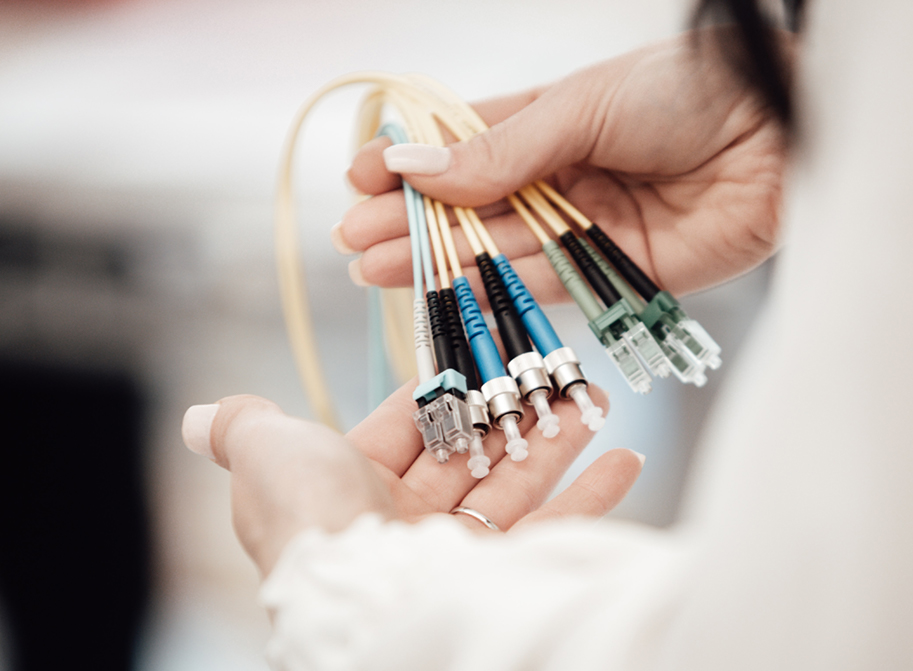As our clients adopt cloud infrastructure, we increasingly get questions about converting to a fiber-optic (fiber) Internet connection. To help with the decision, we’ve put together 5 considerations for fiber Internet.
Fiber Internet is More Reliable
There are several reasons why fiber Internet is more reliable. The first is that it transmits data via light (as opposed to a copper wire) and is less susceptible to moisture seeping into the lines. Internet connectivity based on copper lines (cable Internet, DSL, etc.) relies on dry endpoints for optimum reliability.
Additionally, fiber can transmit data over longer distances as compared to copper-based methods. Both DSL and cable Internet have distance limitations, making them less reliable and more restrictive for large building or campuses.
Fiber Internet is Built for Speed
Fiber Internet is engineered to run at very high rates of speed. While your Internet bill is determined by the service you select, we typically see fiber Internet connections run at higher speeds for the same or sometimes even slightly lower monthly costs compared to a cable Internet connection.
In addition to the speed of the download portion of the circuit (the part of the connection web surfing uses), fiber generally offers a higher upload portion of the circuit. Faster uploads are necessary for saving files to Office 365, Teams, and SharePoint, sending large emails, making video calls or live-streaming, and using Remote Desktop sessions. For most markets, we see fiber connections quoted in symmetrical speeds (same up/down numbers).
What speeds are available? In most markets, we see 100mbps/100mbps (megabits per second, the rate of data transfer) connections available. Some markets now have 1000/1000 connections (often called gig Internet speed), depending on where your business is located. If your business is located close to a residential area, you are more likely to have 1000/1000 connections available. Industrial areas are typically low density, so service providers are slow to upgrade infrastructure in those areas as they result in longer payback periods.
We also see commercial building owners pay for large fiber circuits and/or fiber infrastructure (cabling in the ground) to their buildings allowing tenants to share the fiber cable to the building but not the Internet service itself. This shared infrastructure can be beneficial to all tenants in a building by allowing them to share the fiber connectivity but deploy secure Internet connectivity to all tenants.
You Will Need a Fast Firewall
At Solution Builders, we recommend and ask clients to purchase the proper firewall designed to handle their Internet connectivity. Many times when a client increases Internet speeds, they must also purchase a faster firewall. This practice remains the same with fiber connectivity. You need to scale the firewall to 1) Internet speeds, and 2) firewall features and software (filtering technology, VPNs, etc.) on the firewall.
If your firewall wasn’t designed to handle the faster fiber Internet speeds, your users won’t be able to take advantage of the speeds you are paying for. For example, if you pay for 1000mbps of Internet but your firewall is only rated to handle 600mbps, the max speed you will get through the firewall is 600mbps, essentially wasting that extra 400mbps.
You Can Improve Site to Site Communication Speeds
If your business has multiple locations, fiber Internet could eliminate the older point-to-point connections you currently use. This is because fiber connections are typically the same speeds up and down and you can run a VPN connection between sites and still maintain fast connectivity for your end users. Older point-to-point connections are typically very expensive, and the monthly cost can be eliminated or rolled into a very fast fiber Internet connection.
The downside of using a VPN for site-to-site communications is geographic routing. Typically, if you are using VPN connections between sites in the same city or close by, the connection would route locally (if you use the same carrier for both sides of the VPN and the locations are close). However, if the sites are 200 miles from each other, the Internet traffic may be routed to another very large city 500 miles away, then to its final destination, thus slowing down the overall speed of the data transfer. For example, the Solution Builders corporate headquarters is in the Minneapolis, MN area. If we have a client with locations in Minneapolis and Rochester, MN, the Internet traffic is typically routed from Minneapolis through Chicago to Rochester, traveling much further than the 90 miles between Minneapolis and Rochester.
Your Users Will Like the Speed
Finally, your staff will appreciate the extra speed. Fiber is fast for both download and upload speeds making the day go much smoother for your staff. Saving and syncing files to OneDrive, uploading to Teams or using web-based applications are all much faster with a fiber Internet connection.
We hope our 5 considerations for fiber Internet helps you along the decision-making process. We’re pretty good at all of this fiber Internet stuff, so let us know if you need some help.





 Published: April 28, 2022
Published: April 28, 2022